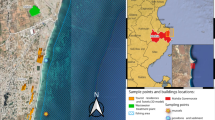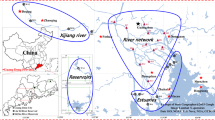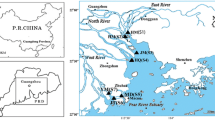Abstract
Adyar and Cooum, the two rivers intersecting Chennai city, are exposed to serious pollution due to the release of large quantities of dumped waste, untreated wastewater and sewage. Sediments can act as repository for emerging organic contaminants. Hence, we have monitored the occurrence and risk associated with plasticizers [six phthalic acid esters (PAEs), bis(2-ethyl hexyl adipate) (DEHA)] and bisphenol A (BPA) in surface riverine sediments of Adyar and Cooum rivers from residential/commercial, industrial and electronic waste recycling sites. Σ7plasticizers (PAEs + DEHA) in the Adyar riverine sediment (ARS) and Cooum riverine sediment (CRS) varied between 51.82–1796 and 28.13–856 ng/g, respectively. More than three-fourth of Σ7plasticizers came from bis(2-ethylhexyl) phthalate (DEHP), in accordance with the high production and usage of this compound. BPA varied between 10.70–2026 and 7.58–1398 ng/g in ARS and CRS, respectively. Average concentrations of plasticizers and BPA were four times higher in electronic waste (e-waste) recycling sites when compared with industrial and residential/commercial sites. BPA and DEHP showed a strong and significant correlation (R2 = 0.7; p < 0.01) in the e-waste sites thereby indicating common source types. Sites present at close proximity to raw sewage pumping stations contributed to 70% of the total BPA observed in this study. For the derived pore water concentration of plasticizers and BPA, the ecotoxicological risk has been found to be higher in ARS over CRS. However, sediment concentrations in all the sites of ARS and CRS were much below the recommended serious risk concentration for human (SRChuman) and serious risk concentration for ecotoxicological (SRCeco).




Similar content being viewed by others
References
Adeogun, A. O., Ibor, O. R., Omogbemi, E. D., Chukwuka, A. V., Adegbola, R. A., Adewuyi, G. A., et al. (2015). Environmental occurrence and biota concentration of phthalate esters in Epe and Lagos Lagoons, Nigeria. Marine Environmental Research, 108, 24–32.
Benjamin, S., Pradeep, S., Josh, M. S., Kumar, S., & Masai, E. (2015). A monograph on the remediation of hazardous phthalates. Journal of Hazardous Materials, 298, 58–72.
Biedermann-Brem, S., & Grob, K. (2009). Release of bisphenol A from polycarbonate baby bottles: Water hardness as the most relevant factor. European Food Research and Technology, 228(5), 679–684.
Cadogan, D., Papez, M., Poppe, A., Pugh, D., & Scheubel, J. (1994). Assessment of the release, occurrence and possible effects of plasticizers in the environment. Progress in Rubber and Plastics Technology, 10(1), 1–19.
Centre for Food Safety. (2012). Endocrine disrupting chemicals in food, 48, 75; Centre for Food Safety, Food and Environmental Hygiene Department, The Government of the Hong Kong Special Administrative Region, August 2012. Accessed 22 Dec 2019.
Chakraborty, P., Mukhopadhyay, M., Sampath, S., Ramaswamy, B. R., Katsoyiannis, A., Cincinelli, A., et al. (2019a). Organic micropollutants in the surface riverine sediment along the lower stretch of the transboundary river Ganga: Occurrences, sources and ecological risk assessment. Environmental Pollution, 249, 1071–1080.
Chakraborty, P., Sampath, S., Mukhopadhyay, M., Selvaraj, S., Bharat, G. K., & Nizzetto, L. (2019b). Baseline investigation on plasticizers, bisphenol A, polycyclic aromatic hydrocarbons and heavy metals in the surface soil of the informal electronic waste recycling workshops and nearby open dumpsites in Indian metropolitan cities. Environmental Pollution, 248, 1036–1045.
Chemical Weekly. (2009). Bisphenol A: A techno-commercial profile (pp. 1–7). https://www.scribd.com/document/61513871/Bisphenol-a-2009. Accessed 2 Jan 2020.
Chen, C.-W., Chen, C.-F., & Dong, C.-D. (2013). Distribution of phthalate esters in sediments of Kaohsiung Harbor, Taiwan. Soil and Sediment Contamination: An International Journal, 22(2), 119–131.
Chen, C.-F., Chen, C.-W., Ju, Y.-R., & Dong, C.-D. (2017). Determination and assessment of phthalate esters content in sediments from Kaohsiung Harbor, Taiwan. Marine Pollution Bulletin, 124(2), 767–774.
Deshayes, S., Eudes, V., Bigourie, M., Droguet, C., & Moilleron, R. (2017). Alkylphenol and phthalate contamination of all sources of greywater from French households. Science of the Total Environment, 599, 883–890.
ENVIS Centre on Hygiene, Sanitation, Sewage Treatment Systems and Technology. (2018). National status of waste water generation and treatment. http://www.sulabhenvis.nic.in/Database/STST_wastewater_2090.aspx. Accessed 18 June 2019.
European Commission. (2011). Amending directive 2002/72/EC as regards the restriction of use of bisphenol A in plastic infant feeding bottles. https://eur-lex.europa.eu/legal-content/EN-RO/TXT/?uri=CELEX:32011L0008. Accessed 14 Dec 2019.
Fierens, T., Servaes, K., Van Holderbeke, M., Geerts, L., De Henauw, S., Sioen, I., et al. (2012). Analysis of phthalates in food products and packaging materials sold on the Belgian market. Food and Chemical Toxicology, 50(7), 2575–2583.
Flint, S., Markle, T., Thompson, S., & Wallace, E. (2012). Bisphenol A exposure, effects, and policy: A wildlife perspective. Journal of Environmental Management, 104, 19–34.
Fu, P., & Kawamura, K. (2010). Ubiquity of bisphenol A in the atmosphere. Environmental Pollution, 158(10), 3138–3143.
Fu, P., Kawamura, K., Pavuluri, C., Swaminathan, T., & Chen, J. (2010). Molecular characterization of urban organic aerosol in tropical India: Contributions of primary emissions and secondary photooxidation. Atmospheric Chemistry and Physics, 10(6), 2663–2689.
Giridharan, L., Venugopal, T., & Jayaprakash, M. (2009). Assessment of water quality using chemometric tools: A case study of river Cooum, South India. Archives of Environmental Contamination and Toxicology, 56(4), 654–669.
Guruge, K. S., Goswami, P., Watanabe, I., Abeykoon, S., Prabhasankar, V., Binu, K., et al. (2017). Trace element distribution and risk assessment in South Indian surface waterways. International Journal of Environmental Science and Technology, 14(1), 1–18.
Hahladakis, J. N., Velis, C. A., Weber, R., Iacovidou, E., & Purnell, P. (2018). An overview of chemical additives present in plastics: Migration, release, fate and environmental impact during their use, disposal and recycling. Journal of Hazardous Materials, 344, 179–199.
He, P.-J., Zheng, Z., Zhang, H., Shao, L.-M., & Tang, Q.-Y. (2009). PAEs and BPA removal in landfill leachate with Fenton process and its relationship with leachate DOM composition. Science of the Total Environment, 407(17), 4928–4933.
Huang, C., Wu, L.-H., Liu, G.-Q., Shi, L., & Guo, Y. (2018). Occurrence and ecological risk assessment of eight endocrine-disrupting chemicals in urban river water and sediments of South China. Archives of Environmental Contamination and Toxicology, 75, 1–12.
Huang, P.-C., Tien, C.-J., Sun, Y.-M., Hsieh, C.-Y., & Lee, C.-C. (2008). Occurrence of phthalates in sediment and biota: Relationship to aquatic factors and the biota-sediment accumulation factor. Chemosphere, 73(4), 539–544.
Huang, Y., Wong, C., Zheng, J., Bouwman, H., Barra, R., Wahlström, B., et al. (2012). Bisphenol A (BPA) in China: A review of sources, environmental levels, and potential human health impacts. Environment International, 42, 91–99.
Jiang, Y., Yuan, L., Liu, L., Shi, L., Guang, A.-L., & Mu, Z. (2018). Bisphenol A in the Yellow River: Sorption characteristics and influential factors. Journal of Hydrology, 564, 307–313.
Kawahata, H., Ohta, H., Inoue, M., & Suzuki, A. (2004). Endocrine disrupter nonylphenol and bisphenol A contamination in Okinawa and Ishigaki Islands, Japan—Within coral reefs and adjacent river mouths. Chemosphere, 55(11), 1519–1527.
Koniecki, D., Wang, R., Moody, R. P., & Zhu, J. (2011). Phthalates in cosmetic and personal care products: Concentrations and possible dermal exposure. Environmental Research, 111(3), 329–336.
Lee, Y.-M., Lee, J.-E., Choe, W., Kim, T., Lee, J.-Y., Kho, Y., et al. (2019). Distribution of phthalate esters in air, water, sediments, and fish in the Asan Lake of Korea. Environment International, 126, 635–643.
Li, Z., Zhang, W., & Shan, B. (2019). The effects of urbanization and rainfall on the distribution of, and risks from, phenolic environmental estrogens in river sediment. Environmental Pollution, 250, 1010–1018.
Lijzen, J., Baars, A., Otte, P., Rikken, M., Swartjes, F., Verbruggen, E., et al. (2001). Technical evaluation of the Intervention Values for Soil/sediment and Groundwater. Human and ecotoxicological risk assessment and derivation of risk limits for soil, aquatic sediment and groundwater; Technical evaluation of the intervention values for soil/sediment and groundwater. Report 711701023. Bilthoven, The Netherlands: RIVM.
Liu, H., Cui, K., Zeng, F., Chen, L., Cheng, Y., Li, H., et al. (2014). Occurrence and distribution of phthalate esters in riverine sediments from the Pearl River Delta region, South China. Marine Pollution Bulletin, 83(1), 358–365.
Liu, H., Liang, H., Liang, Y., Zhang, D., Wang, C., Cai, H., et al. (2010). Distribution of phthalate esters in alluvial sediment: A case study at JiangHan Plain, Central China. Chemosphere, 78(4), 382–388.
Mackintosh, C. E., Maldonado, J., Hongwu, J., Hoover, N., Chong, A., Ikonomou, M. G., et al. (2004). Distribution of phthalate esters in a marine aquatic food web: Comparison to polychlorinated biphenyls. Environmental Science and Technology, 38(7), 2011–2020.
Mackintosh, C. E., Maldonado, J. A., Ikonomou, M. G., & Gobas, F. A. (2006). Sorption of phthalate esters and PCBs in a marine ecosystem. Environmental Science and Technology, 40(11), 3481–3488.
Mathieu-Denoncourt, J., Wallace, S. J., de Solla, S. R., & Langlois, V. S. (2015). Plasticizer endocrine disruption: Highlighting developmental and reproductive effects in mammals and non-mammalian aquatic species. General and Comparative Endocrinology, 219, 74–88.
Mortazavi, S., Bakhtiari, A. R., Sari, A. E., Bahramifar, N., & Rahbarizadeh, F. (2013). Occurrence of endocrine disruption chemicals (bisphenol a, 4-nonylphenol, and octylphenol) in muscle and liver of, Cyprinus carpino common, from Anzali Wetland, Iran. Bulletin of Environmental Contamination and Toxicology, 90(5), 578–584.
MSME. (2013). Brief industrial profile of Chennai district. http://dcmsme.gov.in/dips/ips%20chennai_revised.pdf. Accessed 20 July 2019.
Omar, T. F. T., Aris, A. Z., Yusoff, F. M., & Mustafa, S. (2018). Occurrence, distribution, and sources of emerging organic contaminants in tropical coastal sediments of anthropogenically impacted Klang River estuary, Malaysia. Marine Pollution Bulletin, 131, 284–293.
Pignotti, E., & Dinelli, E. (2018). Distribution and partition of endocrine disrupting compounds in water and sediment: Case study of the Romagna area (North Italy). Journal of Geochemical Exploration, 195, 66–77.
Ramirez, M. M. B., Caamal, R. D., & von Osten, J. R. (2019). Occurrence and seasonal distribution of microplastics and phthalates in sediments from the urban channel of the Ria and coast of Campeche, Mexico. Science of the Total Environment, 672, 97–105.
Ramzi, A., Gireeshkumar, T., Rahman, K. H., Manu, M., Balachandran, K., Chacko, J., et al. (2018). Distribution and contamination status of phthalic acid esters in the sediments of a tropical monsoonal estuary, Cochin-India. Chemosphere, 210, 232–238.
Romero-Franco, M., Hernández-Ramírez, R. U., Calafat, A. M., Cebrián, M. E., Needham, L. L., Teitelbaum, S., et al. (2011). Personal care product use and urinary levels of phthalate metabolites in Mexican women. Environment International, 37(5), 867–871.
Sampath, S., Selvaraj, K. K., Shanmugam, G., Krishnamoorthy, V., Chakraborty, P., & Ramaswamy, B. R. (2017). Evaluating spatial distribution and seasonal variation of phthalates using passive air sampling in southern India. Environmental Pollution, 221, 407–417.
Sathish, N., Jeyasanta, K. I., & Patterson, J. (2019). Abundance, characteristics and surface degradation features of microplastics in beach sediments of five coastal areas in Tamil Nadu, India. Marine Pollution Bulletin, 142, 112–118.
SCHEER (Scientific Committee on Health, Environmental and Emerging Risks). (2019). https://ec.europa.eu/health/sites/health/files/scientific_committees/scheer/docs/scheer_o_015.pdf. Accessed 12 Nov 2019.
Selvaraj, K. K., Sundaramoorthy, G., Ravichandran, P. K., Girijan, G. K., Sampath, S., & Ramaswamy, B. R. (2015). Phthalate esters in water and sediments of the Kaveri River, India: Environmental levels and ecotoxicological evaluations. Environmental Geochemistry and Health, 37(1), 83–96.
Sidhu, S., Gullett, B., Striebich, R., Klosterman, J., Contreras, J., & DeVito, M. (2005). Endocrine disrupting chemical emissions from combustion sources: Diesel particulate emissions and domestic waste open burn emissions. Atmospheric Environment, 39(5), 801–811.
Srivastava, A., Sharma, V. P., Tripathi, R., Kumar, R., Patel, D. K., & Mathur, P. K. (2010). Occurrence of phthalic acid esters in Gomti River Sediment, India. Environmental Monitoring and Assessment, 169(1–4), 397–406.
Stachel, B., Jantzen, E., Knoth, W., Krüger, F., Lepom, P., Oetken, M., et al. (2005). The Elbe flood in August 2002—Organic contaminants in sediment samples taken after the flood event. Journal of Environmental Science and Health, 40(2), 265–287.
Staples, C., van der Hoeven, N., Clark, K., Mihaich, E., Woelz, J., & Hentges, S. (2018). Distributions of concentrations of bisphenol A in North American and European surface waters and sediments determined from 19 years of monitoring data. Chemosphere, 201, 448–458.
Sun, J., Huang, J., Zhang, A., Liu, W., & Cheng, W. (2013). Occurrence of phthalate esters in sediments in Qiantang River, China and inference with urbanization and river flow regime. Journal of Hazardous Materials, 248, 142–149.
USEPA. (2014). United States Environmental Protection Agency, December 2014. 40 CFR Part 423, Appendix A. https://www.epa.gov/sites/production/files/2015-09/documents/priority-pollutant-list-epa.pdf. Accessed 5 Nov 2019.
Wang, J., Bo, L., Li, L., Wang, D., Chen, G., Christie, P., et al. (2014). Occurrence of phthalate esters in river sediments in areas with different land use patterns. Science of the Total Environment, 500, 113–119.
Wilkinson, J. L., Hooda, P. S., Swinden, J., Barker, J., & Barton, S. (2018). Spatial (bio) accumulation of pharmaceuticals, illicit drugs, plasticisers, perfluorinated compounds and metabolites in river sediment, aquatic plants and benthic organisms. Environmental Pollution, 234, 864–875.
Yamazaki, E., Yamashita, N., Taniyasu, S., Lam, J., Lam, P. K., Moon, H.-B., et al. (2015). Bisphenol A and other bisphenol analogues including BPS and BPF in surface water samples from Japan, China, Korea and India. Ecotoxicology and Environmental Safety, 122, 565–572.
Yuan, S. Y., Liu, C., Liao, C. S., & Chang, B. V. (2002). Occurrence and microbial degradation of phthalate esters in Taiwan river sediments. Chemosphere, 49(10), 1295–1299.
Yang, G. C., Wang, C.-L., & Chiu, Y.-H. (2015). Occurrence and distribution of phthalate esters and pharmaceuticals in Taiwan river sediments. Journal of Soils and Sediments, 15(1), 198–210.
Zhang, H., Zhou, Q., Xie, Z., Zhou, Y., Tu, C., Fu, C., et al. (2018). Occurrences of organophosphorus esters and phthalates in the microplastics from the coastal beaches in north China. Science of the Total Environment, 616, 1505–1512.
Zhang, L., Dong, L., Ren, L., Shi, S., Zhou, L., Zhang, T., et al. (2012). Concentration and source identification of polycyclic aromatic hydrocarbons and phthalic acid esters in the surface water of the Yangtze River Delta, China. Journal of Environmental Sciences (China), 24(2), 335–342.
Zhang, Y., Liang, Q., Gao, R., Hou, H., Tan, W., He, X., et al. (2015). Contamination of phthalate esters (PAEs) in typical wastewater-irrigated agricultural soils in Hebei, North China. PLoS ONE, 10(9), e0137998.
Acknowledgements
The authors would like to thank MoEFCC (Ministry of Environment, Forest and Climate Change) for Project No. Q-14011/43/2013-CPW (EHC) and Selective Excellence initiative of SRM Institute of Science and Technology under signature programs competition, criteria for academic excellence, SRM Institute of Science and Technology Kattankulathur campus.
Author information
Authors and Affiliations
Corresponding author
Additional information
Publisher's Note
Springer Nature remains neutral with regard to jurisdictional claims in published maps and institutional affiliations.
Electronic supplementary material
Below is the link to the electronic supplementary material.
Rights and permissions
About this article
Cite this article
Mukhopadhyay, M., Sampath, S., Muñoz-Arnanz, J. et al. Plasticizers and bisphenol A in Adyar and Cooum riverine sediments, India: occurrences, sources and risk assessment. Environ Geochem Health 42, 2789–2802 (2020). https://doi.org/10.1007/s10653-020-00516-3
Received:
Accepted:
Published:
Issue Date:
DOI: https://doi.org/10.1007/s10653-020-00516-3




